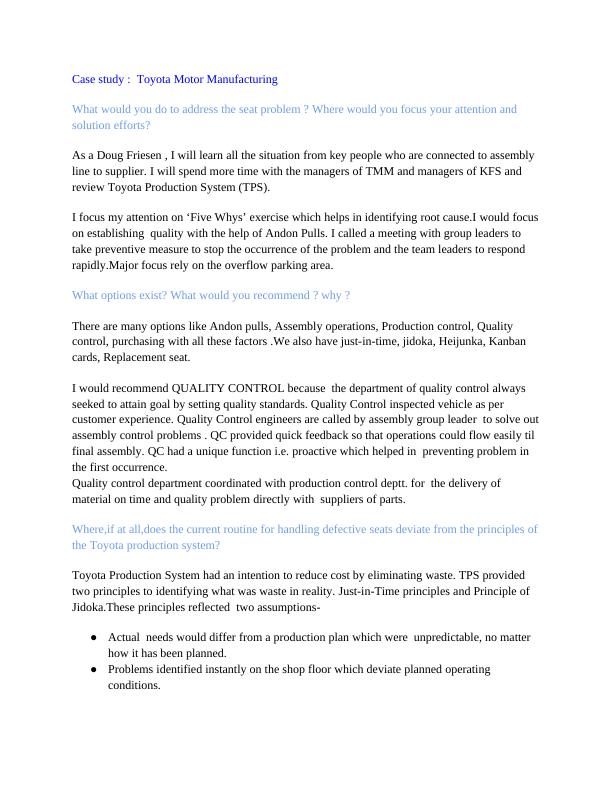Ask a question from expert
Toyota Motor Manufacturing
3 Pages835 Words897 Views
Added on 2019-09-30
Toyota Motor Manufacturing
Added on 2019-09-30
BookmarkShareRelated Documents
Case study : Toyota Motor ManufacturingWhat would you do to address the seat problem ? Where would you focus your attention and solution efforts?As a Doug Friesen , I will learn all the situation from key people who are connected to assembly line to supplier. I will spend more time with the managers of TMM and managers of KFS and review Toyota Production System (TPS).I focus my attention on ‘Five Whys’ exercise which helps in identifying root cause.I would focuson establishing quality with the help of Andon Pulls. I called a meeting with group leaders to take preventive measure to stop the occurrence of the problem and the team leaders to respond rapidly.Major focus rely on the overflow parking area.What options exist? What would you recommend ? why ?There are many options like Andon pulls, Assembly operations, Production control, Quality control, purchasing with all these factors .We also have just-in-time, jidoka, Heijunka, Kanban cards, Replacement seat.I would recommend QUALITY CONTROL because the department of quality control always seeked to attain goal by setting quality standards. Quality Control inspected vehicle as per customer experience. Quality Control engineers are called by assembly group leader to solve outassembly control problems . QC provided quick feedback so that operations could flow easily til final assembly. QC had a unique function i.e. proactive which helped in preventing problem in the first occurrence.Quality control department coordinated with production control deptt. for the delivery of material on time and quality problem directly with suppliers of parts.Where,if at all,does the current routine for handling defective seats deviate from the principles ofthe Toyota production system?Toyota Production System had an intention to reduce cost by eliminating waste. TPS provided two principles to identifying what was waste in reality. Just-in-Time principles and Principle of Jidoka.These principles reflected two assumptions-●Actual needs would differ from a production plan which were unpredictable, no matter how it has been planned.●Problems identified instantly on the shop floor which deviate planned operating conditions.

End of preview
Want to access all the pages? Upload your documents or become a member.